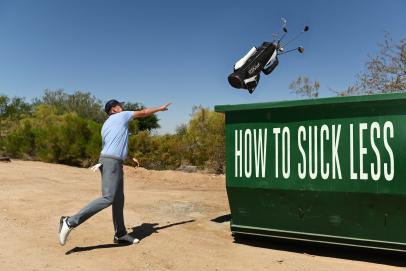From The Archives
Lee Trevino: I ‘guarantee’ you’ll fix your slice with one of these six tips

Lee Trevino is a legend of the game in every sense of the word. He's perhaps the most colorful character golf has ever seen. Maybe its best-ever ball-striker, too. And with six majors, he's a top-tier Hall of Famer.
The Merry Mex turned 82 years-young this week, and he's still a fixture at driving ranges throughout the country, dispensing tips to any golfer who asks for them.
Back in 1992, it was Golf Digest who came asking, specifically, for anti-slice tips in what would become one of that year's cover stories (you can read the full issue right here).
"I hate to be blunt, but the the slice-curing things teachers are telling golfers are dead wrong," Trevino says in the subsequent cover story. "Follow my suggestions. Some of them may sound a little unorthodox...but they work. I guarantee it. Listen to old Lee Buck, and you'll get rid of that banana ball forever."
Sold! So...what are the tips?
Anti-Slice Tip #1: Feel a 'figure 8' swing

When paired with an open clubface, it's swinging over-the-top and cutting across the ball that causes a big slice. To combat this and to get your swing moving more from in-to-out, Trevino wants you to take the club back along the target line, then letting your arms drop inward.
"The best mental image to produce a draw is thinking of the swing as a figure 8, I've used this image throughout my career," he says. "The swing of most slicers resembles a figure 8, but they run the race backward."
Anti-Slice Tip #2: Tweak your grip

Trevino says that for some golfers, strengthening your grip—so your right hand is more underneath the club—helps prevent a clubface that's too open. But for others, it prevents them from being able to release the club fully. That's why Trevino says to tread carefully and, as we wrote about earlier this year, find the grip that's best for you.
"When I want to draw the ball, I don't strengthen my grip. I put my right hand in a weak position," Trevino says. "It enables me, on the downswing, to rotate my right hand as fast and fully as I can without fear of hooking."
Anti-Slice Tip #3: Hands back to where they started
Trevino writes that a common fault he sees with golfers is starting with their hands too far behind the club at address. By the time they get to impact, their hands and clubhead are in different positions, which can throw off your clubface alignment. Instead, position your hands at setup slightly ahead of the ball, Trevino says.
"At impact, your hands will roughly return to the position you were in at address, with the clubface square instead of open," he says.

Anti-Slice Tip #4: Head behind ball
The second part of the 'hands back' tip, Trevino says, is to ensure your head stays behind the ball by the time you get to impact. This helps you hit up on the ball, which reduces spin, and creates space for your arms to swing from in-to-out.
"Don't feel like you pull with the left arm alone," he says. "Swing the club through with both your arms, and keep your head behind the ball."
Anti-Slice Tip #5: Left armpit to left hip
Often, slicers can tend to turn too much on the backswing, Trevino says. Turning is good, but for some golfers too much of it can cause them to lose control of the club in transition—and send it over the top.
"Keep the healthy muscular tension that runs from your left armpit down to your lift hip," Trevino says. "Without that tension, you will try to get power from the arms and shoulders, and you'll come over the top on the downswing."
Anti-Slice Tip #6: Feel your left knee flex

A common theme in Trevino's article is trying to help golfers stop throwing their arms over the top too soon. One cause of this, he says, is from "spinning out" their right shoulder early on the downswing. Instead, Trevino wants you to feel like your left leg bends during the first half of the downswing.
"If you slice, it's an even-money bet that you straighten your left leg at the beginning of the downswing," Trevino writes. "To draw the ball, the left leg must remain flexed. As the left knee moves toward the target, you should have the definite sensation that the left knee is closer to the target line."
Once again, you can read the full article, and the rest of the Golf Digest archive, right here.
BONUS TIP FOR SLICERS
If you haven't already, I'd highly recommend taking a look around Golf Digest Schools if you're serious about improving your game. Yes, I know I'm biased, but there's also a ton of good stuff. And if you use the code "CYBER" you can get 50% on an Annual Subscription here.
Anyway, if you happened upon this article, it's probably because you struggle with the occasional slice. In which case, I think you'd enjoy this "10 faults, fixed" video series from the legendary Butch Harmon. A big admirer of Trevino's swing, one swing feel Butch says he likes giving to golfers is the feeling of keeping their right shoulder back as they swing though on the downswing.





